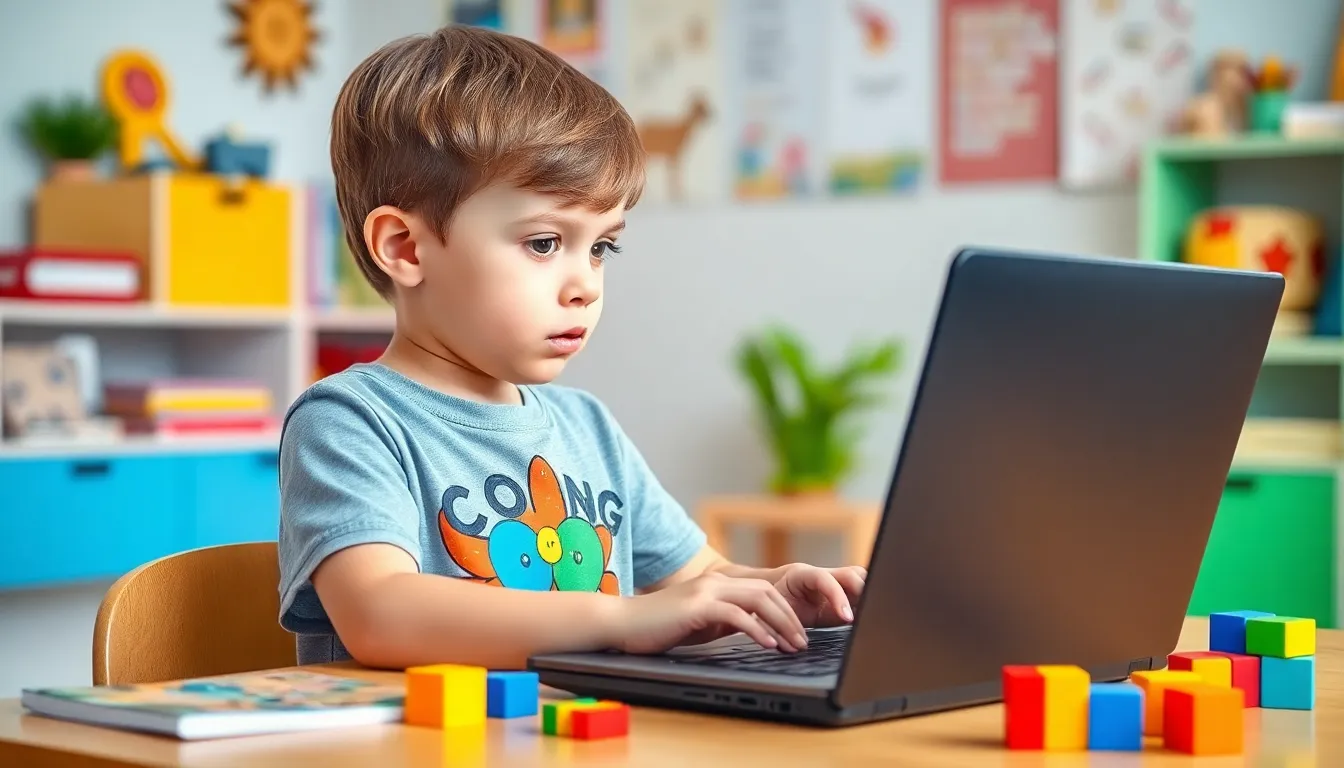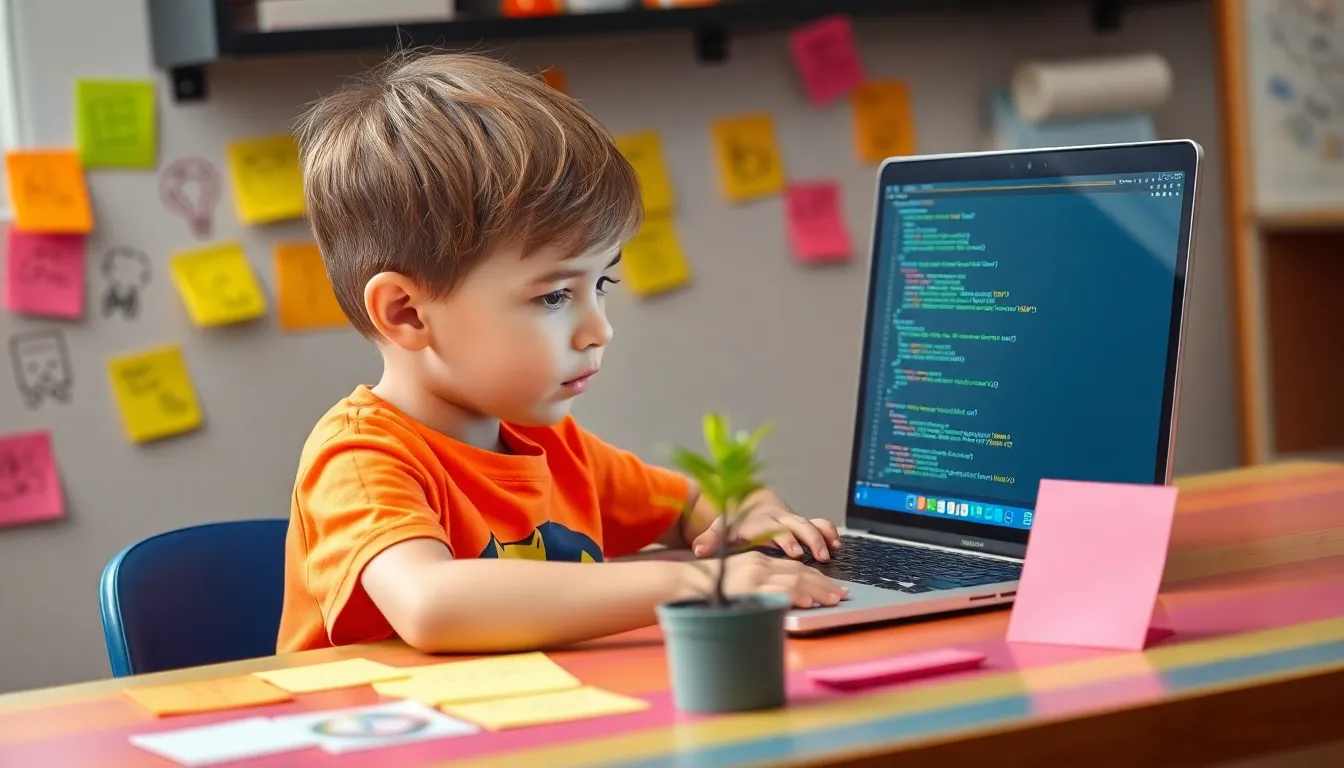In a world where apps reign supreme and robots might just take over, teaching kids to code is like handing them the keys to a digital kingdom. Imagine your child creating their own game or designing an app that could revolutionize snack time. Sounds fun, right? Coding isn’t just for tech whizzes anymore; it’s become an essential skill for the next generation.
With coding tutorials specifically tailored for kids, learning can be as exciting as a treasure hunt. These tutorials turn complex concepts into playful adventures, making sure that every young coder feels like a superhero. So why not spark their curiosity and creativity? Dive into the world of coding where imagination meets technology, and watch as your child transforms from a curious learner to a confident creator.
Table of Contents
ToggleOverview of Coding Tutorials for Kids
Coding tutorials for kids introduce essential programming concepts in a fun and engaging manner. Many platforms, such as Scratch and Code.org, provide interactive lessons designed specifically for young learners. These resources break down complex ideas into digestible tasks, allowing children to grasp fundamentals without feeling overwhelmed.
Games and projects enhance the learning experience, keeping children motivated. Through tutorials, kids often create their own games or simple applications, providing a sense of achievement. This hands-on approach fosters problem-solving skills that extend beyond coding.
Different age groups benefit from tailored tutorials. Younger children might interact with visual programming interfaces, while older kids may explore text-based languages like Python. These varied learning resources cater to the diverse needs of young coders.
Parents and educators play a crucial role in guiding children through these tutorials. By engaging in coding activities together, they promote interest and help reinforce learning concepts. Structured environments, whether at home or in classrooms, encourage collaboration and creativity.
Community support exists for both kids and their mentors. Online forums, coding camps, and local workshops provide avenues for sharing knowledge and experiences. This connection creates a sense of belonging within the coding community, fostering long-term engagement in STEM fields.
Ultimately, coding tutorials empower children to develop technical skills and enhance creativity. They cultivate an environment that nurtures innovation, enabling young minds to transform ideas into reality.
Benefits of Learning to Code Early

Learning to code early offers significant advantages for children. They develop essential skills that extend beyond technology.
Cognitive Development
Cognitive development flourishes through coding. Children enhance critical thinking and logical reasoning skills as they learn to break problems into smaller parts. Engaging with programming languages stimulates brain activity, promoting better memory and attention. Kids improve their ability to think abstractly when they visualize different coding structures. Additionally, they gain a sense of accomplishment by completing coding tasks. Each successful project reinforces their cognitive skills, making complex concepts easier to understand over time. Overall, coding challenges encourage analytical thinking, preparing them for real-world situations.
Creative Problem Solving
Creative problem solving thrives in a coding environment. Kids tackle challenges through innovative thinking, learning how to approach obstacles from different angles. Experiments with code allow them to test ideas and explore various solutions. Each coding project serves as a canvas for their imagination, letting them express creativity while applying logic. When children create their own games or apps, they learn to iterate on their designs and refine their ideas. This practice fosters resilience, as they discover that failure is part of the learning process. Ultimately, coding nurtures a mindset of creativity paired with problem-solving skills, equipping children for future challenges.
Types of Coding Tutorials Available
Various types of coding tutorials support kids in their learning journey. These formats cater to different preferences and help engage young learners effectively.
Online Platforms
Online platforms offer interactive coding tutorials designed for varying skill levels. Websites like Scratch and Code.org enable kids to grasp essential programming concepts through engaging lessons. These platforms utilize visual programming interfaces for younger users, simplifying complex ideas. Older students can delve into text-based languages like Python on these sites. Additionally, these online resources include projects that promote creativity while enhancing problem-solving skills. Kids enjoy creating games or simple programs, which sustains interest and nurtures confidence.
Mobile Applications
Mobile applications serve as convenient tools for learning coding on the go. Apps such as Tynker and Hopscotch allow kids to engage with programming through gamified experiences. Interactive lessons break down tough concepts into fun activities. Through challenges and projects, children can develop skills at their own pace. These applications often include community features, enabling young coders to share their creations and receive feedback. In turn, this fosters collaboration and a sense of belonging among learners.
In-Person Workshops
In-person workshops provide structured environments for children to learn coding collaboratively. Local coding camps and community centers offer hands-on experience with expert guidance. Workshops often cater to specific age groups, ensuring content matches participants’ skill levels. Interactive group activities help build teamwork and communication skills while reinforcing coding concepts. Many of these workshops culminate in projects that allow kids to showcase their creations. This type of engagement helps solidify knowledge and encourages a lively learning atmosphere.
Best Coding Languages for Kids
Choosing the right coding language can enhance a child’s learning experience. Two popular options include Scratch for younger learners and Python for those ready to tackle more complex programming tasks.
Scratch
Scratch serves as an excellent starting point for kids. It uses visual blocks to teach programming concepts without overwhelming beginners. Through fun projects, children build animations and simple games. They express creativity while developing essential problem-solving skills. Scratch’s community feature allows young coders to share their creations, fostering collaboration and inspiration. This platform suits kids aged 8 to 16, making coding accessible and enjoyable.
Python
Python stands out as a versatile language suitable for older kids. It emphasizes readability, allowing new programmers to grasp concepts quickly. Beginners can work on various projects, from simple scripts to complex applications. Python supports numerous libraries that introduce kids to game development, data analysis, and web programming. Its popularity in educational settings encourages collaboration and community learning. Generally, children aged 10 and up benefit the most from Python tutorials, as they can engage with real-world programming applications.
Tips for Choosing the Right Tutorial
Selecting the right coding tutorial requires careful consideration. Factors such as age appropriateness and learning style play crucial roles in ensuring effective learning.
Age Appropriateness
Age appropriateness remains vital when choosing coding tutorials for kids. Programs like Scratch target children aged 8 to 16, using engaging visual blocks to teach basic concepts. Older kids, typically 10 and up, benefit from Python due to its simplicity and versatility in creating various projects. Tutorials aligned with a child’s developmental stage enhance understanding and retention. A tutorial that resonates with the child’s age fosters motivation and engagement, providing a fun learning experience.
Learning Style Considerations
Learning style considerations are essential for maximizing the effectiveness of coding tutorials. Visual learners thrive with platforms that utilize graphics, like Scratch, allowing interactive project creation. Auditory learners benefit from tutorials that integrate sound instructions and discussions. Kinesthetic learners excel through hands-on projects that encourage experimentation and exploration. Acknowledging these learning preferences helps parents and educators select tutorials that align with individual needs, ultimately fostering a richer coding experience. Engaging with an appropriate learning style enhances retention and inspires creativity, driving curiosity in young learners.
Teaching kids to code opens up a world of possibilities. It nurtures creativity and problem-solving skills while laying the foundation for future success in an increasingly digital world. With the right tutorials and resources, children can embark on an exciting journey of learning that transforms them into confident creators.
Parents and educators play a vital role in this process, providing guidance and support that enhances the learning experience. By fostering a collaborative environment and encouraging exploration, they can help children thrive in coding. As kids engage with coding through various platforms and languages, they not only gain technical skills but also develop a mindset that embraces challenges and innovation. Embracing coding education today equips young minds for tomorrow’s opportunities.




